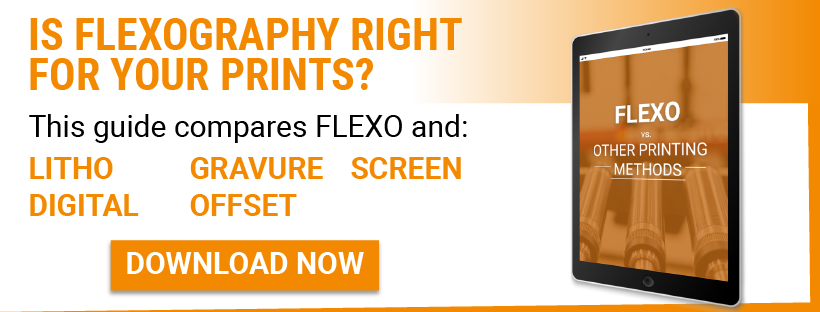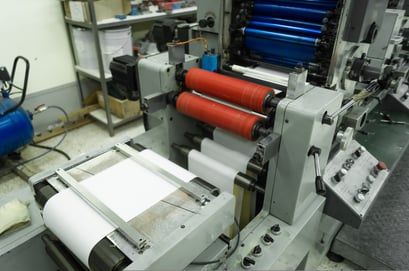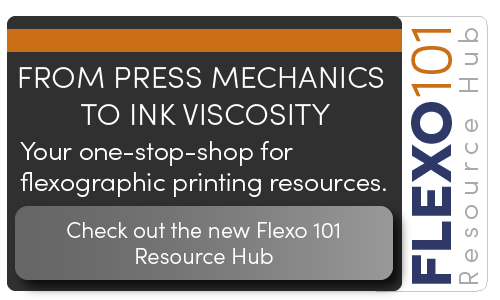Flexo 101 | The 5 Major Types of Printing Presses
Every business regardless of industry, size, or age, invests in product packaging, marketing materials, or a combination of both. As such, the printing industry and the methods and technology fueling it has seen steady growth over the past several decades.
To meet the growing and ever-changing needs of the industrial, manufacturing, and distribution markets, the printing industry features several different operational methods and types of printing presses, each with its unique use depending on the size, color, effect, and quantity needed.
Choosing the right method of printing for your application is important, and partnering with a trusted supplier is even more so. For more information about choosing the correct method of printing for your industry, download our free guide below: Flexo vs Other Printing Methods
While there are several different printing methods available on the market today, there are 8 main styles of presses that are in use today:
- Digital (inkjet) Printers (Short to medium run)
- Screen Printers (Large volume)
- Flexographic Printing Machine (large volume)
- Offset Printers
- Rotogravure Printing Machines
When it comes time to expand a product lineup, introduce a new product, or renovate existing packaging, it’s important to have a clear understanding of each type of printing method and press type before partnering with a print house. Below, let’s dive into each style of printing, its advantages, disadvantages, and how each press operates differently.
5 Types of Printing Presses
Digital Printers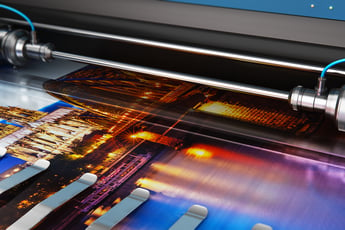
Perfect for short to medium runs, these types of printers are controlled using a computer resulting in a very short turnaround time while still being able to produce full-color prints. Digital Inkjet printers can print on a wide variety of substrates including paper, plastic, canvas, or even doors and floor tiles.
Digital printing has low setup costs which also makes it a great option for small print runs. As with any printing press, the quality of your prints depends on the quality of the machine, and it’s important to look for machines that can continuously feed the substrate.
In-line inkjet printers are sometimes combined with other types of presses to print variable data, such as the mailing addresses on direct mail pieces.
Screen Printers
Since the 1960s, the screen printing process has evolved greatly with the improvement of technology and materials. 
Screen printing techniques rely on a screen woven into a piece of fabric. Certain areas of this mesh are coated with a non-permeable material which allows ink to be pushed through the mesh onto the substrate from the remaining open spaces.
The advantage of screen printing is that the surface of the recipient does not have to be flat and that the ink can adhere to a wide range of materials, such as paper, textiles, glass, ceramics, wood, and metal. Though the aforementioned process of screen printing is standard, there are two types of screen printing, flat and rotary, that differ slightly in the process.
Flat Screen Printing
During the process of flat screen printing, the exposed screen is arranged over the top of the chosen substrate. The ink is then deposited in front of a squeegee. The squeegee then moves over the screen, thus forcing the ink through the mesh and creating a print.
Rotary Screen Printing
The rotary screen process differs slightly. Rather than the squeegee moving atop the screen, it is fixed inside of the screen. The squeegee and screen are mounted ITR, and ink is introduced. When the mounted cylinder rotates, the ink is forced through the mesh via the squeegee. The substrate moves outside of the screen and receives the ink, producing a print.
Flexographic Printing Machine
Flexographic printing typically utilizes an elastomer or polymer image carrier such as sleeves, cylinders, and plates. The image carrier is engraved or imaged to create the design for the final desired product. Ink is transferred from the ink pan via an anilox roll onto the image carrier, where it is then printed onto the substrate.
Flexo printing is most commonly associated with uses in flexible packaging and labels, utilizing a variety of substrates including film, paper, foil, and non-woven.
Flexographic printing can be very cost-effective when printing large runs with basic needs. With proper maintenance and storage, as well as an investment in durable image carrier materials, flexo image carriers can be reused many times before they need to be replaced.
Flexo can print on both porous and non-porous surfaces, making it ideal for a wide variety of substrates, including coated linerboard and paper.
Flexo also utilizes one image carrier per color and can use oil-based inks; it additionally accommodates printing with a wide variety of other inks -- including water-based, solvent-based, and UV inks. Curable inks, such as UV, afford faster drying times. Faster drying can lead to faster production runs.
Offset Printers
Offset lithography, a type of printing method, requires a printing plate, often made from aluminum, which contains an image of the material that needs to be printed. When the plate is inked, only the engraved portion of the printing plate holds ink. That inked image is subsequently transferred (or offset) from the plate to a rubber “blanket” and then onto the substrate. 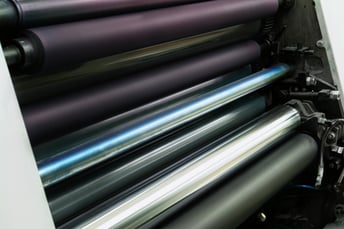
For higher volume work, offset presses use rolls of paper and are so fast that the printed paper needs to be force dried.
Nowadays, offset printers are commonly used to produce books, newspapers, stationery, corrugated board, posters, and more.
Offset generally works with inks that are oil-based along with using some water-based and UV-curable inks. However, one thing to consider about offset is that the plates used in the process are susceptible to oxidation if they're not cared for properly. For this reason, extra maintenance is often necessary to ensure plate quality
Rotogravure Printing Machines
Also known as Gravure, this type of printing works by applying ink to a substrate with the use of a metal plate that is typically mounted onto a cylinder. These plates are often made of copper or chrome. The image or text that is intended for printing is typically laser-etched into the metal plate, a process that often delivers high quality and precise results with good repeatability.

Gravure image carriers are typically much more expensive than Flexo, making the number of prints required to break-even much higher. Gravure, however, has a longer press run time as the cylinders do not require as frequent changing as Flexo. Gravure lead time is usually 3-4 times that of Flexo in the time it takes to manufacture the image carrier.
One of the limitations of gravure printing is that it is generally better suited for porous substrates. This is one of the reasons that gravure is best suited for high-detail printing on applications such as magazine covers.
Industrial Printing Machines | Consult the Experts
Whether you’re looking to invest in a printing operation or find a print house to partner with, understanding the basics of the different printing machines and methods is important.
For flexographic operations and questions on the image carrier, consult the experts with over 100 years of experience in the printing industry. Have questions? Contact us today or check out our new Flexo 101 Resource Hub below, your one-stop shop for Flexo resources, guides, and more!
(Editor's Note: This blog was originally published in July 2022 and was updated in August 2023 to reflect current information.)

